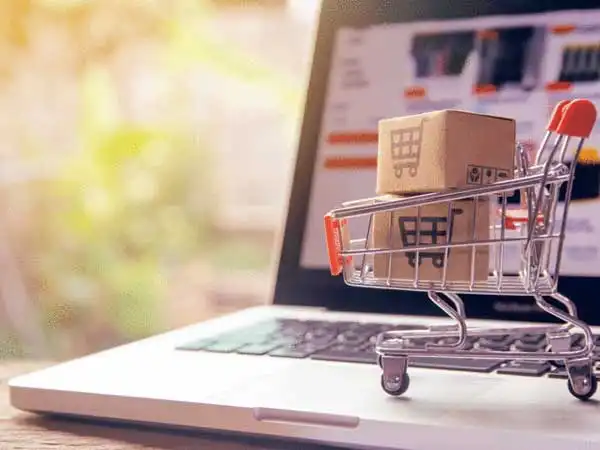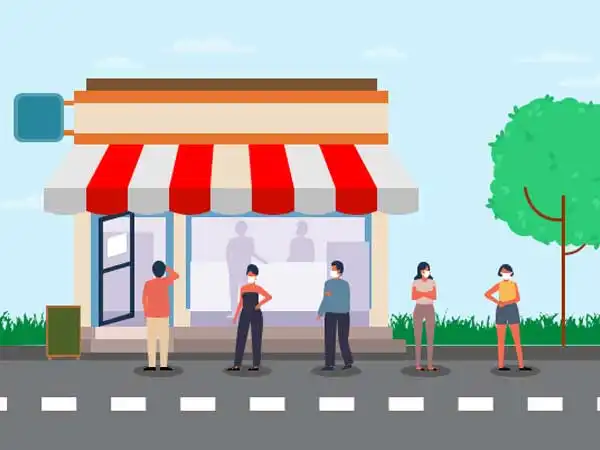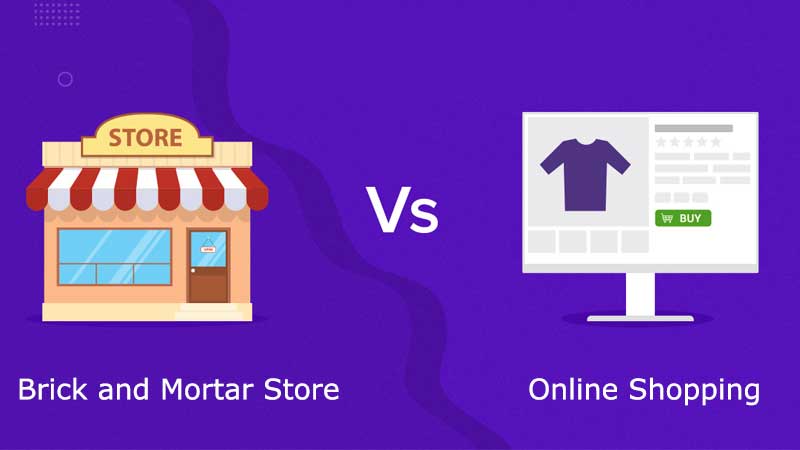The way we shop has undergone a seismic shift in recent years. The rise of online retail giants like Amazon has challenged the dominance of traditional brick-and-mortar stores, leaving consumers with a wealth of options and a crucial question: where should I shop?
Online and brick-and-mortar stores have pros and cons, and the “better” option depends on your individual needs and preferences. Let’s delve into the shopping world, analyzing each approach’s advantages and disadvantages and exploring the cost-saving potential.
Online Shopping: Convenience at Your Fingertips

Pros:
Convenience:
- 24/7 Shopping: Ditch store hours and shop in your pajamas at 3 am! There is no need to rush out during lunch breaks or fight weekend crowds.
- Shop from Anywhere: Whether you’re on vacation, stuck at work, or curled up on the couch, you’re just a click away from millions of products.
- Multitasking Maestro: Shop while waiting for laundry, during commercial breaks, or between meetings. Online shopping seamlessly integrates into your busy life.
Selection:
- Global Marketplace: Access products from international retailers and niche brands you might not find locally. There are no more limitations based on your geographic location.
- Long Tail Products: Discover unique and hard-to-find items that wouldn’t be stocked in physical stores due to space constraints.
- Customized Options: Many online stores offer customizable products like phone cases, jewelry, or apparel, catering to your preferences.
Price Comparison:
- Comparison Websites & Apps: Use dedicated tools to instantly compare prices across multiple retailers, ensuring you get the best deal.
- Price History Tracking: Monitor price fluctuations to snag items at their lowest point over time.
- Deal Alerts & Coupons: Set up notifications for sales, discounts, and coupon codes to maximize your savings.
Promotions & Discounts:
- Exclusive Online Offers: Many online stores reward customers with exclusive deals, flash sales, and coupon codes unavailable in physical stores.
- Subscription Services & Auto-Replenishment: Enjoy discounts and convenience with subscription services for essentials like razors, pet food, or cleaning supplies.
- Loyalty Programs & Reward Points: Earn points on every purchase that can be redeemed for discounts, free shipping, or exclusive perks.
Reviews & Ratings:
- Consumer Insights: Read genuine customer reviews and product ratings to gain valuable insights and make informed decisions.
- Expert Opinions: Access reviews and comparisons from professional reviewers and industry experts for complex or high-value purchases.
- Community Recommendations: Leverage online forums and social media groups to discover hidden gems and get personalized product suggestions.
Additional points to consider:
- Environmental Impact: Consider the potential environmental impact of online shopping due to packaging and transportation. Choose eco-friendly shipping options or shop locally when possible.
- Supporting Local Businesses: If supporting local businesses is a priority, look for online platforms that connect you with local stores and artisans.
Responsible online shopping requires awareness of its benefits and potential drawbacks. By making informed choices and strategically utilizing the advantages, you can enjoy a convenient, efficient, and cost-effective shopping experience.
Cons
Waiting Time:
- Delayed Gratification: Unlike brick-and-mortar stores where you walk out with your purchase, online shopping means waiting for deliveries, which can range from a few days to several weeks. This can be frustrating for impulsive purchases or urgent needs.
- Delivery Window Woes: Specified delivery windows can disrupt your schedule, requiring you to be home to receive the package. Missed deliveries can lead to additional delays and rescheduling hassles.
- International Shipping: Overseas orders have longer wait times, potential customs delays, and higher shipping costs, further hindering instant gratification.
Return Hassles:
- Reverse Logistics: Returning unwanted items involves repackaging, finding return labels, and potentially paying return shipping costs, which can be a deterrent, especially for low-value items.
- Restocking Fees: Some retailers charge restocking fees for returned items, further adding to the financial burden of returns.
- Time-Sensitive Returns: Certain items have limited return windows, adding pressure to initiate and complete the return process within the timeframe.
Limited Sensory Experience:
- Sight & Specs: Relying on photos and product descriptions can be deceiving. Colors may not appear true-to-life, the fit may be inaccurate, and materials might feel different than expected.
- Touch & Trial: You cannot physically touch, try on, or test products before buying, which can be crucial for clothing, makeup, or electronics. This can lead to sizing issues, product dissatisfaction, and unnecessary returns.
- Quality Inspection: Assessing product quality and potential defects is solely based on photos and reviews, increasing the risk of receiving damaged or faulty items.
Security Concerns:
- Data Breaches: Online stores hold your personal and financial information, making them vulnerable to data breaches and identity theft. Choose reputable stores with secure payment gateways and data encryption practices.
- Phishing Scams: Deceptive emails or websites mimicking legitimate retailers can trick you into sharing personal information or credit card details. Be cautious of unsolicited emails and only shop on verified websites.
- Fake Products: Counterfeit products abound online, especially for famous brands. Research the seller’s reputation and compare prices to avoid scams.
Shipping Costs:
- Free Shipping Thresholds: While many stores offer free shipping above a certain purchase amount, smaller orders can incur significant shipping charges, negating potential savings.
- Expedited Shipping Fees: Faster delivery options come with premium prices, which can quickly add up, especially for larger or heavier items.
- International Shipping Costs: International shipping involves customs fees and higher base rates, making online shopping from overseas considerably more expensive.
Additional Points:
- Customer Service: While some online stores offer excellent customer service, others may have limited accessibility or impersonal interactions compared to the face-to-face assistance in brick-and-mortar stores.
- Impulse Purchases: The ease of adding items to a virtual cart can lead to impulsive buys and exceeding your budget. Practice mindful shopping and set spending limits before browsing online.
Remember, the key to navigating online shopping effectively is knowing the advantages and disadvantages. By being a discerning consumer, taking safety precautions, and planning your purchases carefully, you can maximize the benefits and minimize the potential drawbacks of this convenient shopping method.
Brick-and-Mortar Stores: The Tactile Experience

Pros:
Instant Gratification:
- Walk-in, Walk-out: Brick-and-mortar stores offer the ultimate satisfaction of taking your purchase home immediately. No waiting for deliveries, tracking packages, or dealing with potential delays. The item is yours when you pay, perfect for impulsive buys or urgent needs.
- Browse & Discover: The joy of strolling through aisles, discovering new products, and serendipitously finding hidden gems cannot be replicated online. The physical presence of products invites exploration and spontaneous purchases.
Sensory Experience:
- Touch & Feel: Unlike photos and descriptions, brick-and-mortar stores allow you to physically touch and assess the quality of materials, textures, and finishes of products. This is crucial for clothing, furniture, electronics, and anything where tactile experience matters.
- Try & Fit: Trying on clothes, testing electronics, or even sampling food ensures a perfect fit or taste before committing to a purchase. This eliminates the hassle of returns and ensures you get precisely what you need.
- Visual Immersion: Experiencing products’ true colors, sizes, and aesthetics in person allows for a more informed purchase decision. You can see how items look in natural light, compare sizes side-by-side, and better understand overall quality.
Expert Advice:
- Personalized Service: Knowledgeable salespeople can answer your questions, offer recommendations based on your needs, and guide you through product features. This personalized attention is invaluable for complex purchases or unfamiliar categories.
- Product Demonstrations: Witnessing products in action through live demonstrations helps you understand their functionality and make informed decisions. This is especially helpful for electronics, appliances, or sporting goods.
Social Interaction:
- Shopping as an Experience: Browsing stores with friends or family, trying on outfits together, and sharing opinions add a social element to shopping. It becomes an enjoyable outing rather than just a transactional activity.
- Community Feel: Supporting local businesses and interacting with store staff fosters a sense of community and connection, something lacking in online shopping.
Returns & Exchanges:
- Hassle-free Returns: Returning unwanted items in-store is often easier than navigating online return processes. You can avoid packaging, shipping costs, and waiting times, making returns smoother and less of a deterrent.
- Immediate Exchanges: If you need a different size or color, in-store exchanges allow you to walk out with the correct item immediately, saving time and frustration compared to waiting for replacements.
Remember, brick-and-mortar stores offer an experience, not just about buying. The sights, sounds, smells, and interactions contribute to a memorable shopping journey that goes beyond just acquiring products.
Additional Points:
- Limited Selection: Smaller stores may not have the same vast variety as online retailers but often focus on curated selections and niche products.
- Store Hours: Restricted by opening and closing times, which can be inconvenient for busy schedules.
- Crowds & Queues: During peak seasons or sales, stores can get crowded, making the shopping experience less enjoyable.
By understanding the unique benefits of online and brick-and-mortar shopping, you can make informed choices based on your needs and preferences, creating a personalized and enjoyable shopping experience.
Cons:
Limited Selection:
- Curated Collections: While the variety might be smaller, brick-and-mortar stores often focus on specific niches or cater to a defined customer base, offering a curated selection of high-quality or trendy products.
- Local & Unique Finds: You might discover local brands, artisan goods, or unique items not readily available online, supporting local businesses and finding one-of-a-kind treasures.
- Try Before You Buy: The ability to touch and try on items can eliminate the need to order multiple sizes or styles online, potentially reducing the number of unwanted returns.
Price Comparison:
- Instant Comparison: While immediate price comparison with every online retailer might not be possible, you can compare prices with nearby stores within the same shopping area.
- Promotional Offers & Sales: Look for in-store coupons, special promotions, or clearance events that might not be advertised online, offering potential savings.
- Negotiation Power: In some cases, particularly for higher-value items, negotiating with store staff might yield better deals than fixed online prices.
Store Hours:
- Weekend Warriors: Plan your shopping trips around store hours during weekends or evenings when you have more flexibility.
- Click & Collect: Utilize “click and collect” options where you order online and pick up in-store at your convenience, bypassing waiting times.
- Shop Local: Support local businesses with convenient opening hours catering to your community’s needs.
Crowds & Queues:
- Strategic Visits: Avoid peak shopping hours like weekends, holidays, or sale periods to minimize crowds and long queues.
- Smaller Stores: Opt for smaller, independent shops during off-peak times for a more relaxed browsing experience.
- Utilize Staff Assistance: Ask store staff for help navigating busy areas or locating specific items to save time and avoid queues.
Impulse Purchases:
- Set a Budget: Stick to a predefined budget and shopping list to avoid impulsive purchases triggered by attractive displays or promotional offers.
- Window Shopping: Enjoy the visual experience without entering stores to admire products without the temptation to buy.
- Ask for Time: When unsure about an item, request time to think before deciding, avoiding rushed purchases you might regret later.
Additional Points:
- Tangible Experience: The sensory experience and social interaction offered by brick-and-mortar stores can add value beyond just the product itself.
- Supporting Local Communities: Choosing local businesses over online giants contributes to your community’s economic well-being and fosters a sense of connection.
Remember, the “better” shopping option depends on your needs and priorities. By weighing the limitations of brick-and-mortar stores against their unique advantages, you can make informed choices and create a fulfilling shopping experience beyond just acquiring products.
Saving Money: Strategies for Both Worlds
Regardless of your preferred shopping method, saving money is always a priority. Here are some tips for both online and brick-and-mortar shoppers:
Online Shopping
1. Utilize Price Comparison Tools:
- Websites: Use dedicated platforms like Google Shopping, PriceGrabber, or ShopSavvy to compare prices across multiple retailers for the same product.
- Browser Extensions: Install browser extensions like Honey or Capital One Shopping Assistant that automatically search for coupons and compare prices while you shop.
- Mobile Apps: Download apps like Slickdeals or RetailMeNot to get notified about deals, coupons, and price drops for your favorite items.
Example: You’re looking for a new pair of running shoes. Use Google Shopping to compare prices from retailers like Nike, Adidas, and Zappos. Find the best deal with free shipping and a 20% discount code through a browser extension.
2. Set Up Deal Alerts & Track Price Fluctuations:
- Websites: Use deal alert websites like CamelCamelCamel (for Amazon) or PriceBlink to track price history and set notifications when your desired price is reached.
- Retailer Emails: Sign up for email alerts from your favorite stores to receive notifications about upcoming sales, new arrivals, and exclusive deals.
- Price Tracking Apps: Use apps like Trackimo or PriceMole to monitor price changes for specific items across different retailers.
Example: You want a new smartphone but prefer to wait for a good deal. Set up a price alert on Trackimo for your desired model. When the price drops to your target budget, you’ll receive a notification and can make your purchase.
3. Take Advantage of Coupons & Discount Codes:
- Coupon Websites & Apps: Browse websites like Couponmall247.com, Coupons.com, or Honey for coupon codes and promo offers for specific stores you’re shopping at.
- Social Media: Follow your favorite brands and retailers on social media as they often announce exclusive coupon codes and flash sales through these platforms.
- Email Subscriptions: Sign up for email lists from websites like Groupon or LivingSocial for daily deals and discounts on various products and services.
Example: You’re buying a new laptop from an online retailer. Check RetailMeNot for any available coupon codes before checkout. You might find a 10% off code, saving you a significant amount on your purchase.
4. Opt for Free Shipping Options:
- Minimum Purchase Requirements: Many online stores offer free shipping if you reach a certain minimum purchase amount. Add filler items to your cart to qualify for free shipping if it makes financial sense.
- Subscription Services: Consider subscription services like Amazon Prime or Walmart+ that offer free shipping on most items along with other benefits like streaming services or early access to deals.
- Click & Collect: Choose “click and collect” options if available, where you order online but pick up your purchase in-store, avoiding shipping costs altogether.
Example: You’re buying a book and a few small items online. The total cost is just below the free shipping threshold. Add a pack of pens to your cart to reach the minimum amount and avoid paying shipping fees.
5. Consider Used or Refurbished Items:
- Websites & Marketplaces: Explore platforms like eBay, Swappa, or Gazelle for used or refurbished electronics, appliances, and other products at significantly lower prices.
- Manufacturer Refurbished: Many brands offer certified refurbished products directly on their websites, often with warranties and guarantees similar to new items.
- Local Thrift Stores: Support your community and potentially find unique treasures at local thrift stores or consignment shops.
Example: You’re looking for a specific camera model, but the new price doesn’t fit your budget. Check Swappa for pre-owned options in excellent condition, potentially saving hundreds of dollars.
6. Stick to Your Shopping List & Avoid Impulse Purchases:
- Create a Budget: Set a spending limit before you start browsing and stick to it.
- Write a Shopping List: Only add items you need or have researched to your cart.
- Use the “Add to Wishlist” Feature: If tempted by something outside your list, add it to a wishlist for later consideration instead of immediately buying it.
- Take Breaks: If overwhelmed by options, step away from the computer for a while to avoid impulsive decisions.
Example: You’re shopping for new clothes online. Create a list of specific items you need and set a budget. Stick to your list and avoid getting distracted by sale items or unrelated products.
Responsible online shopping requires planning, awareness, and utilizing available tools and strategies. By following these tips and adapting them to your needs, you can maximize your savings, avoid unnecessary purchases, and enjoy a more efficient online shopping experience.
Brick and Mortar
1. Shop During Sales & Clearance Events:
- Seasonal Sales: Take advantage of seasonal clearance events like end-of-summer sales for clothing or back-to-school sales for electronics.
- Holiday Promotions: Black Friday, Cyber Monday, and other holiday promotions offer discounts on various items across many stores.
- Department Store Clearance Racks: Don’t underestimate the hidden gems in clearance racks – you might find designer clothes, brand-name cookware, or discounted homeware.
Example: You need a new winter coat. Wait for the end-of-season sale at your favorite department store, where you can find high-quality coats at significantly reduced prices compared to peak season.
2. Use Store Coupons & Loyalty Programs:
- Paper Flyers & Mailers: Check weekly flyers and store mailers for coupons and promotional offers specific to the items you’re interested in.
- Mobile Apps & Online Coupons: Download store apps and sign up for email lists to receive exclusive coupons, birthday discounts, and loyalty program rewards.
- Ask About In-Store Promotions: Don’t hesitate to politely ask store staff if you might not be aware of any ongoing promotions or hidden coupons.
Example: You’re buying groceries at a specific store. Use their mobile app to find coupons for your favorite brands and scan your loyalty card for points and potential discounts.
3. Compare Prices with Online Retailers (Before You Buy):
- Use Phone Apps: Download price comparison apps like ShopSavvy or Amazon Price Check to scan product barcodes in-store and instantly compare prices with online retailers.
- Remember Shipping Costs: Factor in shipping costs when comparing online prices with in-store prices to ensure you’re getting the best deal overall.
- Negotiate (if applicable): In some stores, especially for high-value items like furniture or appliances, polite negotiation might yield better prices than online offers.
Example: You’re considering buying a new TV at an electronics store. Use your phone to compare prices on the same model online, including shipping costs. If the in-store price is slightly higher, politely ask the salesperson if they can match the online price.
4. Consider Generic or Store-Brand Alternatives:
- Quality Comparisons: Compare the quality and features of generic or store-brand products alongside name brands. You might be surprised at the quality and value offered at lower prices.
- Blind Taste Tests: For food and household items, consider blind taste tests or product comparisons to see if you can discern a significant difference between name brands and store-brand alternatives.
- Support Local: Choosing store-brand products can sometimes support local manufacturers and distributors, contributing to your community’s economic well-being.
Example: You need to buy laundry detergent. Instead of automatically reaching for a national brand, compare the ingredients and features of the store-brand detergent. You might find a similar quality product at a fraction of the price, saving you money and supporting your local store.
5. Avoid Impulse Purchases by Setting a Budget:
- Stick to Your List: Create a shopping list before heading out and only buy items on the list. Avoid getting sidetracked by attractive displays or promotional offers.
- Set Spending Limits: Determine your budget for the trip and stick to it. Leave your credit cards at home if necessary to avoid exceeding your limit.
- Take Breaks & Cool Down: If overwhelmed by choices, take a break outside the store or walk around another section to cool down before making any decisions.
Example: You’re buying specific paint supplies at a home improvement store. Set a budget for the paint, brushes, and other essentials. Stick to your list and avoid getting tempted by tools, decorative items, or impulse buys that weren’t originally planned.
Remember, brick-and-mortar shopping offers a unique experience beyond just buying products. By being a savvy shopper, utilizing available resources, and staying focused, you can maximize the benefits of this shopping method, find great deals, and avoid unnecessary purchases. Happy shopping!
The Hybrid Hero: Omnichannel Shopping
The future of retail lies in the hands of the “omnichannel hero”, the savvy shopper who seamlessly navigates online and offline experiences. Retailers have embraced this approach, leading the charge and offering customers a convenient and personalized shopping journey. Let’s explore some examples of these hybrid heroes:
Sephora: This beauty giant seamlessly blends online browsing with personalized in-store experiences. Their mobile app allows customers to reserve makeovers, scan products for details and reviews, and even virtually try on makeup shades. In-store beauty advisors leverage the app to access customer purchase history and preferences, offering tailored recommendations and loyalty program rewards.
Best Buy: The electronics giant seamlessly integrates online and offline shopping. Customers can research products online, compare prices with other retailers, get free Best Buy discount coupons, and even read expert reviews. They can then purchase online for home delivery or in-store pickup or schedule in-home installation for major appliances. Best Buy also offers Geek Squad services, where tech experts can assist with setup, troubleshooting, and repair in-store and remotely.
Nike: The sportswear giant’s “Reserve & Try” program allows customers to reserve items online and try them in-store before buying. They can also scan barcodes in-store to access product information, reviews, and styling tips on their mobile app. Additionally, Nike offers in-store customization options for shoes and apparel, creating a unique and engaging experience. Check out tips on how to save money when shopping for shoes.
Warby Parker: This online eyewear retailer has opened physical locations serving as stores and vision centers. Customers can browse and try on glasses in-store, order online for home delivery, or opt for virtual consultations with opticians. Warby Parker leverages customer data across platforms to offer personalized recommendations and seamless purchase experiences.
Apple: Apple Stores are prime examples of omnichannel excellence. Customers can research products online, book appointments with Genius Bar specialists, and even make purchases online for in-store pickup. The stores serve as showcases for Apple’s ecosystem, where customers can interact with products, receive personalized assistance, and attend workshops.
Macy’s: The iconic department store chain offers a robust omnichannel experience. Shoppers can browse their vast selection online and filter by size, color, brand, and in-store availability. They can then choose home delivery, buy online for in-store pickup, or use the “reserve online, try on in-store” option for apparel. Macy’s mobile app also allows users to scan barcodes for product details, access coupons, and manage loyalty rewards.
TJ Maxx & Marshalls: These off-price retailers offer treasure hunters a unique omnichannel experience. While their inventory constantly changes, shoppers can sign up for email alerts to be notified of new arrivals and sales. They can also use the store locator on the website to find specific items at nearby locations. While online shopping isn’t available, the thrill of the in-store hunt and digital notifications for restocks creates a unique omnichannel experience.
JCPenney: This department store chain caters to budget-conscious shoppers with its omnichannel approach. Customers can browse weekly sales flyers online, create shopping lists, and clip digital coupons. They can then shop online for home delivery or in-store pickup or take advantage of “buy online, ship to store” for free returns. JCPenney also offers salon appointments and same-day pickup for online orders placed before a specific time.
Bed Bath & Beyond: This home goods retailer caters to convenience with its omnichannel strategy. Shoppers can create online registries for weddings, baby showers, or housewarmings, and guests can purchase gifts online or in-store. Bed Bath & Beyond offers curbside pickup for online orders, same-day delivery in select areas, and in-store consultations with design experts.
Nordstrom: This luxury department store chain caters to a discerning clientele with its personalized omnichannel approach. Customers can shop online for designer clothing, shoes, and accessories, with access to detailed product descriptions, styling tips, and virtual consultations with stylists. They can also book in-store appointments for alterations, personal shopping, and beauty consultations, ensuring a seamless and personalized shopping journey.
Walmart: The retail giant offers a comprehensive omnichannel experience, leveraging its vast network of stores and online platforms. Shoppers can browse Walmart extensive selection online, compare prices with other retailers, and choose from various delivery options, including home delivery, in-store pickup, and even same-day delivery for select items. Walmart also offers grocery pickup and delivery, making it a convenient one-stop shop for everyday essentials. These are just a few examples of how leading retailers embrace omnichannel shopping. By combining the convenience of online browsing with the personalized service and tactile experience of brick-and-mortar stores, these “hybrid heroes” are creating a future where shopping is truly customer-centric.
The Bottom Line:
Ultimately, the “better” shopping option is the one that best suits your needs and preferences. Consider factors like convenience, price, selection, and the importance of a physical experience when deciding. Don’t be afraid to experiment and try online and brick-and-mortar stores to find your ideal shopping balance. Remember, the key to saving money lies in intelligent shopping habits, regardless of your chosen platform. Happy shopping!



